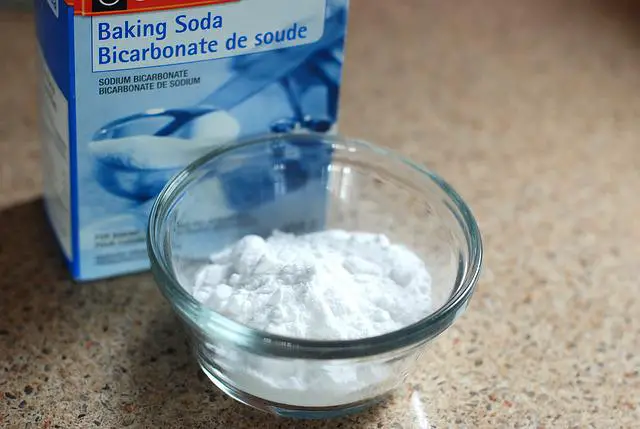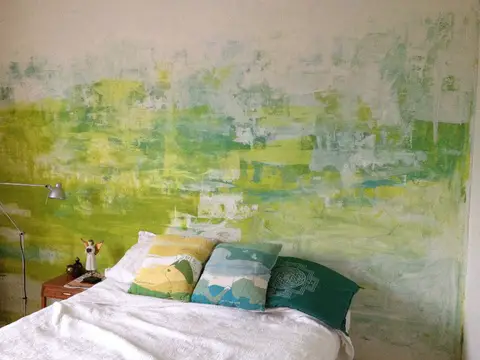Acrylic paint can work wonders for your art, but it can also get splashed on the walls of your studio and leave unsightly stains. When this type of paint dries, it can become water-resistant, so you need to act quickly before it leaves permanent marks on your walls. Luckily, there are things you can find in your household you can use to remove acrylic paint.
You can safely remove acrylic paint from a wall as follows:
- Scrub the stains with a soap and water solution.
- Use baking soda paste.
- Wipe the paint away with rubbing alcohol.
- Dab vinegar on the stains.
- Use acetone for the tougher spots.
- Chip away with a scraper.
- Level hardened acrylic paint stains using sandpaper.
Table of Contents
Steps to Safely Remove Acrylic Pain from a Wall
Scrub the Stains With a Soap and Water Solution
As long as the splashes or spills are still fresh, soap and water should do the trick. Ideally, you should use liquid soap, along with a cloth or sponge for scrubbing. Put liquid soap in water, then apply the solution on the stains. Let it sit for a while before giving it a gentle scrub.
for scrubbing. Put liquid soap in water, then apply the solution on the stains. Let it sit for a while before giving it a gentle scrub.
Use Baking Soda Paste

Baking soda doesn’t just fluff up breads and pastries. It’s also tough on stains if you know how to use it. All you have to do is mix baking soda with water to create a thin paste. Apply the paste to the paint stain and let it sit for a few minutes. Then, scrub the paint away with a sponge.
Wipe the Paint Away With Rubbing Alcohol
Isopropyl or rubbing alcohol is a solvent that works well on stains like acrylic paint. If you have a bottle nearby, you can use it to remove fresh acrylic paint stains
that works well on stains like acrylic paint. If you have a bottle nearby, you can use it to remove fresh acrylic paint stains . Soak a piece of cloth in alcohol, and wipe it on the stains. Note that this method can take time to completely dissolve the paint.
. Soak a piece of cloth in alcohol, and wipe it on the stains. Note that this method can take time to completely dissolve the paint.
Dab Vinegar on the Stains
Vinegar may not be your first choice, since it leaves a strong smell wherever it’s applied. However, it can work well for removing acrylic paint as well. You only need to heat vinegar via a microwave or with a saucepan, and the solution should work for those stubborn stains. You may want to follow up with a cleaner to rid your walls of the vinegar smell.
via a microwave or with a saucepan, and the solution should work for those stubborn stains. You may want to follow up with a cleaner to rid your walls of the vinegar smell.
Use Acetone for the Tougher Spots
Acetone is a potent solvent and is usually effective for stains that have dried. Granted, you might worry that it’ll also chip away at the original paint — not to mention damage walls made of wood. If you apply it properly though, these shouldn’t be major concerns.
Here’s how to remove acrylic paint using acetone :
:
- Clean the stains with a rag to remove dirt and other debris.
- Scrape the paint off.
- Put as much acetone as the stain needs. If it’s a tiny stain, spray the acetone into a cloth before wiping it on the paint. If you’re dealing with serious stains, pour the acetone directly onto the paint.
- Scrub off the acetone-doused paint.
- Wash off the residue.
- Rinse and repeat as many times as needed until all the stains come off.
Chip Away With a Scraper
If the stains are thick enough and have dried, a scraper can be helpful. Gently chisel away the stain with a scraper, taking care not to do this too roughly as you could damage the original paint on your wall as well. After removing the bulk of the stain, remove any residue using any of the solutions and solvents mentioned earlier.
Level Hardened Acrylic Paint Stains Using Sandpaper
Using sandpaper may sound like a bad idea, since there’s a risk of chafing the original wall paint as well. But if done carefully, the sandpaper can remove the dried acrylic paint without causing unnecessary damage. When you use sandpaper, use a gentle wiping motion (as though you’re stroking a beloved pet) and focus on the stain. Once you’re done, remove the residue using the solutions mentioned above.


What To Do With Stubborn Paint Stains
Your acrylic paint may contain exceptionally stubborn pigments that make the stains a nightmare to remove. At this point, you might want to consider more potent solvents. For example, products like Goo Gone can remove paint splatter without damaging the surface underneath.
can remove paint splatter without damaging the surface underneath.

- Works on silicone caulk, adhesive, sealants, tree sap, wet paint, glue, asphalt, ink, marker, soot,...
- Professional grade cleaner removes sticky, gooey, gummy messes
- Superior, extra-heavy duty industrial and institutional degreaser and cleaner
Last update on 2025-05-28 / Affiliate links / Images from Amazon Product Advertising API
In the worst case scenario (i.e., you end up damaging your original wall paint and there are still stains left), you can apply paint thinner on the stains, then paint over the “bald patches” using something similar to the original one used for your walls. If you don’t have the original paint anymore, you can always take a quality photo of your wall, head off to the hardware store, ask the seller about the shade that matches yours the closest, and buy that one.
As much as possible, avoid using products you don’t already have in your home, since they may contain harmful chemicals that’ll give you problems worse than unwanted acrylic stains.
That said, if you don’t want to completely DIY your acrylic paint removal project, I recommend the Safe n’ Easy Citrus Paint & Varnish Removal Gel (available on Amazon.com). This product is capable of removing multiple layers of paint, making it perfect for stubborn stains. At the same time, it’s 100% biodegradable, doesn’t give off any harmful smells, and doesn’t contain toxic chemicals.
- ALWAYS TEST BEFORE USE: Removes acrylic, latex, oil, & water-based paints, varnishes, & stains,...
- PERFECT FOR YOUR DIY PROJECTS: Wood furniture, cabinets, decks, & patios, brick or stone fireplaces,...
- NO CAUSTIC CHEMICALS! Our water-based remover does not contain ANY caustic chemicals commonly found...
Last update on 2025-05-28 / Affiliate links / Images from Amazon Product Advertising API
You can also use the Smart Strip Advanced Paint Remover . This one works on most surfaces, including wood and porcelain. The formula is water-based, 100% biodegradable, and free of harmful substances. Plus, it doesn’t leave an unpleasant smell.
. This one works on most surfaces, including wood and porcelain. The formula is water-based, 100% biodegradable, and free of harmful substances. Plus, it doesn’t leave an unpleasant smell.
- ALWAYS TEST BEFORE FULL USE: Every coating is different. Apply a test patch of Smart Strip Advance...
- WATER-BASED & NON-CAUSTIC: Smart Strip Advanced must remain in a wet state to perform removal. Cover...
- REMOVES MULTIPLE LAYERS OF PAINT: Strips up to 15 layers of acrylic, latex, oil, and water-based...
Last update on 2025-05-28 / Affiliate links / Images from Amazon Product Advertising API

Final Words
There’s no shortage of products that promise to remove paint splatter with a spray and a wipe. But it’s worth trying what you already have in your household to safely remove the stains before using chemicals that are corrosive, have toxic fumes, and are an added expense. If possible, try to remove the stains as soon as they’re made so the process becomes much easier.
Sources
- Medium: How to Remove Acrylic Paint From Wall? — 7 Easy Ways

- Felt Magnet: 5 Liquids That Can Remove Dried Acrylic Paint From Surfaces

- Jae Johns: How to Remove Acrylic Paint Easily

- Nash Painting: 7 Ways to Safely Clean Paint Splatter & Spills

- Rubbing Alcohol: Rubbing Alcohol To Remove Paint

- Hunker: Recipe for Using Vinegar for Dried Paint Removal


